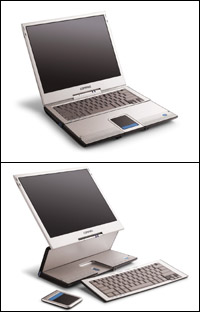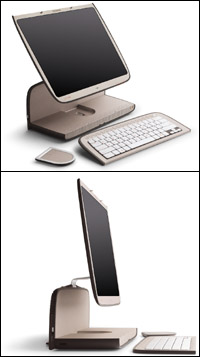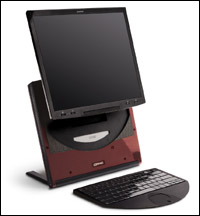|
Can you tell us about any current "concept" projects under way?
RM: Another exciting success for our design team is
a project we code-named "Dual Worlds." One practice we have, that
may be a little different from many of our competitors, is to
bring many of our major customers through our design studios and
share selected concepts with them during the visit. The result
has been a win/win situation for us both. Customers get a glimpse
of product concepts, which helps guide them in their IT planning
process, and the design teams gain direct feedback on their issues,
likes and dislikes. In fact, the Design Center has become one
of the most highly rated parts of the customer visits to Compaq,
with many returning several times for follow-ups. The "Dual Worlds"
project is the result of the lessons gleaned from these visits.
One thing we heard time after time during these
interactions is that the work force continues to become more mobile.
Very often employees found themselves working at home, in hotels,
in airports and on planes. Most of them utilized a laptop computer
for this work and over 40% maintained either a desktop or docking
station solution for those times when they were stationary. It
seems that most users were not comfortable working on laptops
for long periods of time, due to the less than perfect ergonomics
and space constraints that a lightweight portable form factor
imposes on the user. This scenario results in increased cost within
the IT budget to purchase and upgrade these additional units,
not to mention the health dangers an inappropriate ergonomic workspace
configuration could trigger.
Taking this as an opportunity to add customer value
and innovate, we began to look into the issues surrounding the
mobile computing environment, and what new enabling technologies
were available. For this effort we teamed up with Native Design,
a small consultancy based in London. Considerable market research
aimed at understanding the customer's work habits while mobile,
was the first step in the development process. Over the course
of several months this information served as a base to evaluate
potential concept directions. After hundreds of ideas were evaluated,
eliminated, combined and modified, the result was seven unique
form factors, each addressing the issues in totally separate ways.
By leveraging the advances in wireless technologies
such as Blue tooth, the basic concept of these devices was to
allow the user unparalleled freedom in configuring their workspace
while in a mobile environment. Basically, the concept is based
on a common clamshell notebook form factor. However, one of the
unique aspects of the product is that it contains a removable
wireless keyboard and pointing device, which allows the user to
increase his distance from the screen and place the keyboard and
pointing device in a less confining orientation. The ergonomic
transformation is complete when the user articulates the screen
via a dual hinge mechanism, thus raising the height of the display
and allowing adjustment of the screen tilt at the same time. In
retrospect, this was an interesting solution from Compaq, since
our company was founded in the early '80's by bringing portability
to the desktop PC world, and now we have demonstrated a solution
that brings the superior ergonomics of a traditional desktop configuration
to the portable world.
With this product Compaq decided to take a cue from
the Automotive industry and show "Dual Worlds" while still in
a "concept car" stage of development. The response from the media
and from our customers to this, and other projects we have showcased
in this way, has been overwhelming. It is no surprise that everyone
enjoys these intriguing looks into the future, and their feedback
is invaluable during the development process. In the true spirit
of open exploration, Compaq has chosen not disclose which, if
any, of these "visioneering" concepts will make it to market.
However, as a design team, we appreciate the opportunity to share
some our creativity outside the usual bounds of the development
process.
C77: One last question - if your group were an animal, what kind of animal would it be?
RM: An odd
question in deed. Let it suffice to say that we have a cardboard
cutout of a headless chicken borrowed from a graphic design conference
a few years ago, mounted on foam core and prominently displayed
in the studio! Any designer working in a complex, highly competitive,
fast paced, environment such as ours will surely understand.
|
|
  
|